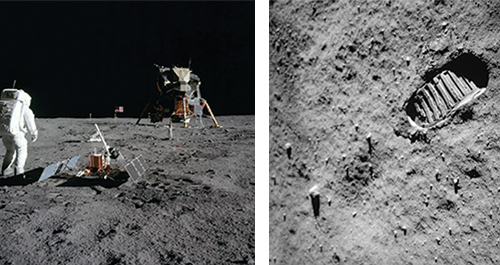The moon’s placement in early 2025 on the World Monuments Watch is an important milestone for NMSU anthropology Professor Emerita Beth O’Leary, who began a journey 25 years ago to preserve significant artifacts and sites on the moon.
O’Leary is a member of the International Scientific Committee on Aerospace Heritage, a part of International Council on Monuments and Sites, a non-governmental organization dedicated to the conservation of the world’s monuments and sites. The Aerospace Heritage Committee wrote the nomination to the World Monuments Fund.
“Cultural resources on the moon so far have been preserved by their remoteness but are vulnerable to damage and destruction from increasing space activities, both national and commercial,” O’Leary says. “The World Monuments Watch calls for global cooperation to preserve the moon’s cultural and scientific legacy.”
The first lunar landing site, created in 1969, is known as Tranquility Base and preserves 106 assorted artifacts related to the event, including the landing module.
The idea to protect the moon originated from one of O’Leary’s graduate students and was supported by a grant from the New Mexico Space Grant Consortium at NMSU. It evolved over the years with subsequent groups of students working on ways to protect the artifacts. One group of students traveled with O’Leary to Santa Fe in 2010 and succeeded in having the artifacts from Apollo 11’s Tranquility Base added to New Mexico’s State Register of Cultural Properties. Other states followed.
O’Leary’s work continues.
“We are excited that lunar sites are recognized internationally,” O’Leary says. “The next step is to create agreements, treaties, essentially protocols and procedures that other nations that are on the moon or will be going to the moon can agree on so that we can protect humanity’s heritage there.”

NMSU anthropology professor emerita Beth O’Leary’s 25-year push to gain protection for artifacts and sites on the moon took a big step forward when the World Monuments Fund named the moon to its 2025 list of heritage sites.

Left: In 2010, a group of NMSU students traveled with Beth O’Leary to Santa Fe and succeeded in having the artifacts from Apollo 11’s Tranquility Base added to New Mexico’s State Register of Cultural Properties. Right: Created in 1969, the first lunar landing site, known as Tranquility Base, preserves 106 assorted artifacts related to the event.

Dove Hall, Room 212
305 N. Horseshoe Drive
Las Cruces, NM 88003